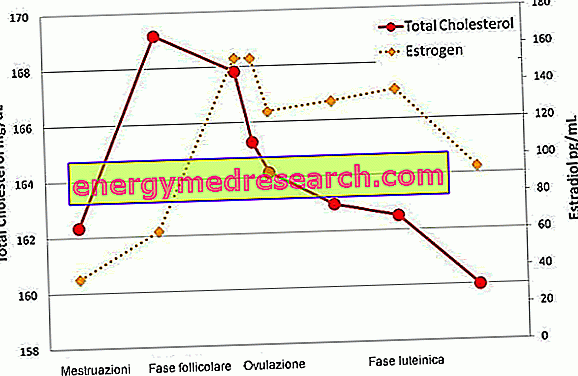Generality
Candida in men is the male variant of the fungal infection known as candidiasis or simply candida.

Caused by the same pathogen that infects women - namely the fungus Candida albicans - candida in humans can manifest itself with balanitis (inflammation of the glans), a characteristic rash and / or thrush (the so-called oral candidiasis).
The diagnosis of candida in humans is simple and fast, as the infection in question produces easily recognizable signs; however, in some situations, further tests may be needed, such as blood or urine tests.
The treatment of candida in humans (as in women) is based on the use of antifungal drugs, including imidazole derivatives and fluconazole.
What is Candida in Man?
The candida in humans is the male version of the fungal infection caused by the fungus Candida albicans .
Also known as male candida, candida in man is responsible for manifestations at the level of the penis, but not only; sometimes, in fact, as with candida in women, it can also affect the skin and / or mucous membrane of the mouth (if not even the entire oropharyngeal tract).
Like candida in women, candida in humans does not generally represent a serious and dangerous condition for the affected person.
Contrary to what most people think, candida affects not only women but men as well.
Brief reminder of what Candida is
Candida (or candidiasis ) is a fungal infection (or mycosis ) caused by the fungus Candida albicans . This fungus is naturally present in the human body; in particular, he loves living in damp and warm environments, such as the mouth, the throat, the gastrointestinal tract and the genitals (vagina and glans).
AS CANDIDA ALBICANS CAUSE THE CANDIDA
Candida albicans is actually a generally harmless fungus for humans, as the so-called "good bacteria" constituting the bacterial flora and the immune system provide to prevent pathological proliferation.
However, when these two control systems fail, Candida albicans begins to multiply intensely, giving rise to the condition known as candida or candidiasis .
What is the immune system in short
The immune system is the defensive barrier, erected by the human body, against infectious agents and other threats from the external or internal environment.
Causes
What are the Causes of Candida in Man?
Candida in men (as well as in women) occurs when the defense mechanisms responsible for controlling the proliferation of Candida albicans fail; as previously mentioned, in fact, the uncontrolled proliferation of Candida albicans causes this fungus to infect the colonized organism.
Candid-promoting factors in humans
Several factors can compromise the efficiency of the defense mechanisms responsible for controlling the proliferation of Candida albicans and contribute to the development of candida in humans; among these factors, the most important are:
- Improper use of antibiotics . The abuse of antibiotics causes the reduction of the bacterial flora present in the human body and is responsible for regulating the proliferation of microorganisms such as Candida albicans ;
- Bad personal hygiene . The approximate drying of the penis (or vagina, in the case of a woman), after a shower or a bath, creates a moist and warm habitat, ideal for the proliferation of the fungus Candida albicans ;
- Use of poor quality intimate cleansers . Poor quality soaps and shower gels can irritate the penis (or vagina, in the case of a woman) and promote fungal multiplication;
- Suffering from immunodepression . People suffering from immunosuppression have a weak, inefficient immune system, therefore they are prone to infections.
Generally, immunosuppression is a typical problem of: people suffering from diseases such as AIDS (which undermine the integrity of the immune system), those who take immunosuppressive drugs (ie drugs that lower the immune system) and the elderly (for physiological reasons) ;
- Suffering from diabetes mellitus . In diabetic individuals, the high amount of glucose in the blood (high blood sugar) promotes the multiplication of the fungus Candida albicans, as it represents, for the latter, an almost inexhaustible source of nourishment;

- Obesity . The skin folds formed by the fat rolls represent an ideal environment for the multiplication of the fungus Candida albicans . Therefore, obese people are more at risk of candidiasis;
- Sexual relationship with an infected person . The man who has sex with a woman with candida can develop the same infection, as he is exposed to an important colony of Candida albicans ;
- Share the use of towels, underwear or soaps with an infected person ( mixed use of infected objects ). In these circumstances, what is described during sexual intercourse with candida sufferers is repeated.
Is Candida in Man a Sexually Transmitted Disease?
According to the medical community, despite the fact that it may arise from sexual intercourse with affected people, candida in humans is not to be considered a sexually transmitted disease (such as syphilis or genital herpes ).
Epidemiology
In humans, candida is less common than in women.
Statistical studies have shown that male candida is more prevalent among men suffering from diseases, such as diabetes mellitus and AIDS, and among men taking chemotherapy drugs to treat cancer.
Furthermore, similar research has shown that male candida is more common among uncircumcised men .
Symptoms and Complications
The male candida can express itself at different levels: in fact, it can affect the penis, the surface of the skin and / or the mucous membrane of the mouth and pharynx.
- When it involves the penis, it is the protagonist of an inflammatory process against the glans (the terminal part of the penis), known as the medical term of balanitis ;
- When it strikes the skin, it causes the onset, in certain areas of the body, of an itchy rash characterized by small red spots ;
- When, finally, it compromises the good health of the oral cavity, it causes the so-called thrush or oral candidiasis .
Candida Masculine and Balanite
In causing balanitis, candida in humans is associated with symptoms and signs, such as:
- Red and swollen glans;
- Irritation and itching at the glans level;
- Ulcerative lesions on the glans, combined with whitish, dense, lumpy and bad-smelling secretions;
- Phimosis (narrowing of the foreskin);
- Pain and bleeding during urination;
- Pain during sexual activity ( dyspareunia ).
In some cases, in men with candida balanitis, it is possible for the inguinal lymph nodes to swell and become painful to the touch.
Did you know that ...
The redness of the glans is the onset symptom of male candida balanitis; then follow the itching and irritation of the head of the penis, the ulcerative lesions and the other symptoms previously listed.
Male Candida and Rash
In the skin, the male candida can cause a rash (or rash ), characterized by itching, burning, pain and small red spots ; sometimes, this eruption also involves the secretion of a white-yellowish substance, similar to a curd.
As a rule, the cutaneous manifestations of the male candida affect the regions of skin where two adjacent skin areas come into contact with each other, rubbing; examples of such regions - which are defined with the expression of "skin folds" - are the axillae, the groin, the interdigital areas (ie between the fingers), the folds formed by the localized fat and the perineum (between genitals and anus ).
Curiosity: why do certain anatomical zones stimulate the multiplication of Candida albicans ?
As stated, the candida fungus loves to live in warm-humid environments.
In areas of the body such as the armpits or between the folds of the localized fat, there is an ideal temperature and humidity level for the multiplication of Candida albicans .
Candida Masculine and Lily of the Valley

In the mouth, in particular on the mucous membrane of the tongue, palate and pharynx, the male candida can cause the appearance of whitish, milky, point, lenticular or confluent plaques .
It should be noted that these formations are often associated with symptoms, such as: burning, difficulty swallowing (therefore the patient struggles to eat) and lack of perception of flavors.
Did you know that ...
The main factors favoring oral candidiasis are:
- Excessive use of antibiotics;
- The use of dental prostheses;
- Immunodepression, caused by serious diseases such as AIDS;
- Diabetes mellitus.
Who to contact?
If symptoms occur at the genital level, it is advisable to consult a doctor who specializes in infections of the genitourinary tract .
If the symptoms occur only in the mouth or on the skin, however, the consultation of your own doctor may suffice.
Complications of Candida in Man
If it affects immunosuppressed men (ie with a weak immune system) or with particular pathologies (eg diabetes), the male candida (as well as the candida in women) can degenerate into a condition known as invasive candidiasis (or invasive candida ).
Invasive candida is the infection resulting from the passage of the fungus Candida albicans ( fungemia or funghemia ) into the blood and its diffusion into important organs, such as the heart ( endocarditis ), the brain ( encephalitis ), the eyes ( endophthalmitis ) or bones ( osteomyelitis ).
Invasive candida can be fatal for the patient, therefore it represents a medical emergency, to which immediate relief must be given.
Deepening: complications of oral candida
In both men and women, in the presence of a state of immunodepression, oral candida can degenerate into candida esophageal, due to the spread of the fungus Candida albicans in the esophagus.
The esophageal candida is responsible for difficulty and pain during swallowing, abdominal pain, nausea and vomiting.
WHO IS MORE AT RISK OF INVASIVE CANDIDOSIS
The men most at risk of invasive candidiasis are:
- AIDS patients . As the reader will remember, AIDS affects the efficiency of immune defenses;
- Those who take immunosuppressive drugs . This is the case, for example, of individuals undergoing an organ transplant;
- Those who are undergoing chemotherapy for cancer treatment. Chemotherapy has the side effect of reducing the efficiency of the immune system;
- Diabetics . Diabetes promotes the proliferation of Candida albicans ;
- Subjects who need to use dialysis periodically. This is the case of men with kidney failure ;
- Subjects who, due to a certain health condition, must undergo insertion of a central venous catheter .
Did you know that ...
It is the practice of doctors to advise diabetics and dialysis patients, who develop candida, hospitalization, so that they can count on a more effective cure than fungal infection (a more effective treatment, it guarantees a lower risk of complications).
Diagnosis
In general, for the diagnosis of candida in humans (as well as in women), an accurate physical examination is sufficient, during which the doctor analyzes the symptom picture in detail, and a careful evaluation of the clinical history (or medical history ) of the patient.

In particular situations, however, it may happen that, for diagnostic confirmation, it becomes essential to carry out tests, such as blood tests, urine tests, skin swabs or buccal swabs .
When do you need further diagnostic investigations?
- When the symptoms of candida in humans are severe or persist, despite treatment;
- When the patient is a victim, without clear reasons, of recurrent episodes of candida;
- When there is doubt that the patient suffers from an undiagnosed form of diabetes or some sexually transmitted disease.
How to behave when Candida gets sick for the first time
Men (and women) who develop candida for the first time must undergo a thorough medical examination, which includes, in addition to the observation of symptoms, also the evaluation of clinical history.
The information that emerges from clinical history is of fundamental importance for understanding the precise factors triggering candidiasis and for planning the most appropriate therapeutic plan.
If the doctor has doubts or thinks possible the presence of a serious favoring disease not yet diagnosed (such as diabetes), he will most likely resort to the diagnostic examinations already mentioned several times, that is skin and / or buccal swab, blood test and urine analysis.
Therapy
The treatment of candida in humans (as in women) is based on the use of specific medicinal products with anti-fungal power ( antifungal drugs ), but could also include, if the doctor deems it appropriate, the use of corticosteroids on administration topical .
Among the antifungal drugs used in the presence of male candida, we note:
- Imidazole derivatives, in particular when the manifestations of the infection are oral or cutaneous, e
- Fluconazole and analogues, especially when the infection caused balanitis.
It is also important to stress the therapeutic importance of personal hygiene and temporary abstention from sexual activity .
Imidazole derivatives
Imidazole derivatives are anti-fungal drugs, which act by destroying the fungal cell membrane.
The mode of administration of these drugs - which occur in the form of oral creams or gels - is the topical route (therefore the patient must apply them directly where the infection occurs).
The imidazole derivatives most used in the presence of candida in humans are: clotrimazole, econazole, ketoconazole and miconazole .
Among the side effects of these medicines is the burning after their application; if this sensation becomes unbearable and develops into severe skin irritation, the patient should immediately expose the problem to his doctor, who will most likely change the type of therapy.
Fluconazole

Fluconazole is an antifungal drug, belonging to the triazole family; compared to imidazole derivatives, its anti-fungal power is greater .
In the case of male candida, fluconazole is used when the infection has affected the genitals, causing balanitis; however, it should be pointed out that it could also be useful in cases of cutaneous or oral candidiasis, which do not respond to therapy based on imidazole derivatives .
Fluconazole, therefore, is ideal for the treatment of male candida that has affected the genitals and for the treatment of male cutaneous or oral candida that is resistant to imidazole derivatives.
Generally, fluconazole intake is taken orally via tablets. Once in the body, this antifungal drug acts against some enzymes that Candida albicans uses to reproduce and survive; in other words, it destroys the molecules essential to the reproduction of the fungus responsible for candida.
| The main side effects of fluconazole: |
Nausea Abdominal pain Diarrhea Flatulence |
Corticosteroids: when are they needed?
Belonging to the category of anti - inflammatories, topical administration corticosteroids are among the drugs against male candida, when the infection causes a highly itchy rash .
It is important to remind readers that all corticosteroids are drugs that, in the event of prolonged intakes, can cause various serious side effects; this is why their intake can only take place after a medical prescription.
Attention to personal hygiene
Paying attention to personal hygiene is a fundamental part of the care of male candida.
In this sense, among the rules to be followed, we highlight:
- Use of good quality detergents, so as not to irritate the skin;
- Be careful, after each shower, to dry all the anatomical areas where the Candida Albicans fungus can multiply (ie, genitals, armpits, perineum, etc.);
Did you know that ...
In the case of genital candida, to keep the private parts as dry as possible, doctors recommend the use of wide and non-compressed underpants.
Temporary abstention from Sexual Activity
Although the use of condoms prevents the transmission of candida, doctors advise to avoid sexual relations with the partner for the duration of the treatment and to resume only after recovery.
Prevention
The main measures to prevent candida in humans are:
- Do not abuse antibiotics (follow the instructions given by your doctor);
- Maintain body weight (therefore, lose weight, in the case of overweight or obesity);

- In the presence of conditions favoring candida (eg: diabetes, AIDS, chemotherapy immunodepression etc.), take maximum care of personal hygiene and avoid sexual relations with people infected with Candida albicans ;
- Wash the intimate parts with quality detergents that do not irritate the glans skin;
- Carefully dry the private parts after each shower;
- Use a condom if the partner is infected.
Prognosis
How long does it take to heal from Male Candida?
If the treatment is timely and adequate and if the patient is in good health, candida in humans usually heals within a couple of weeks .



